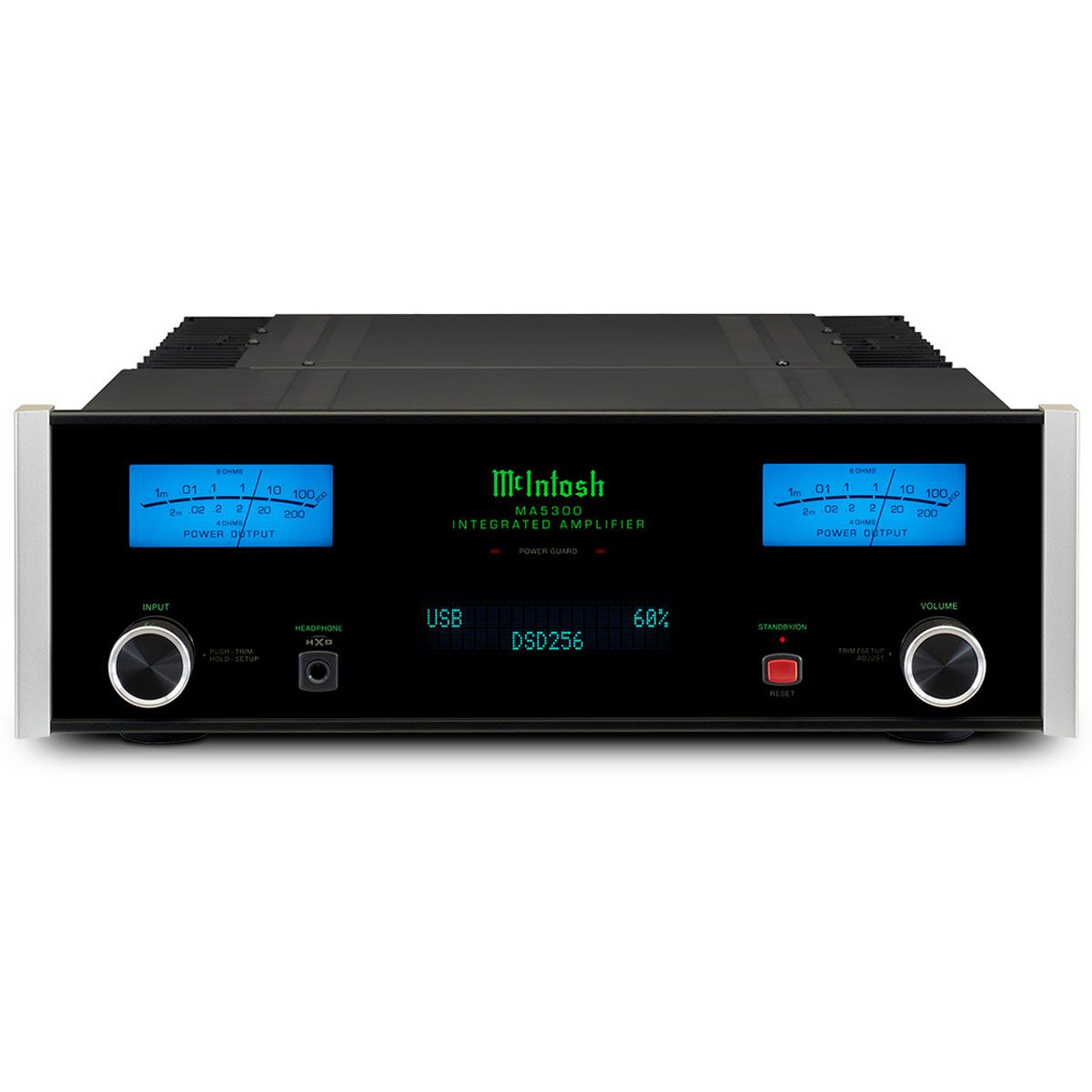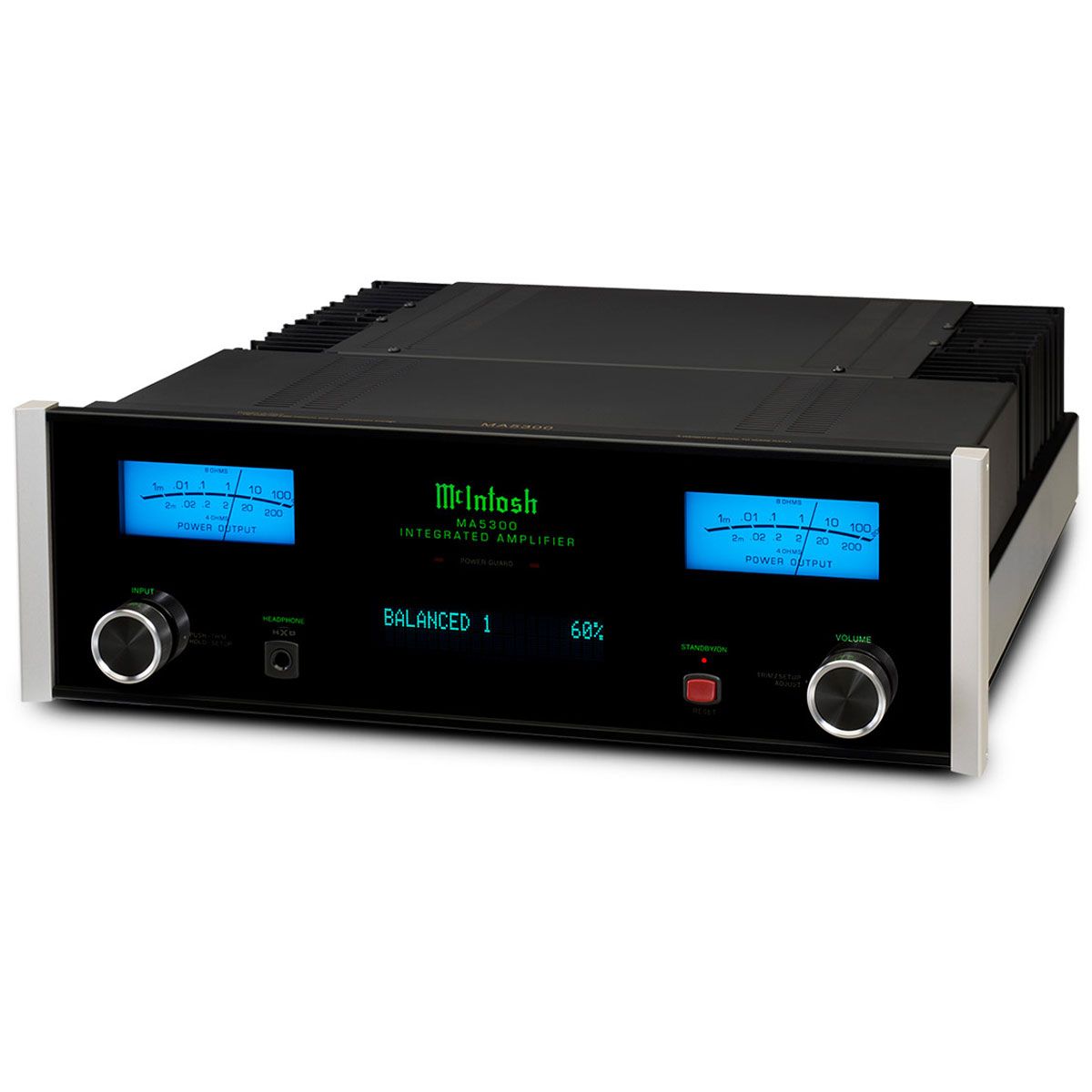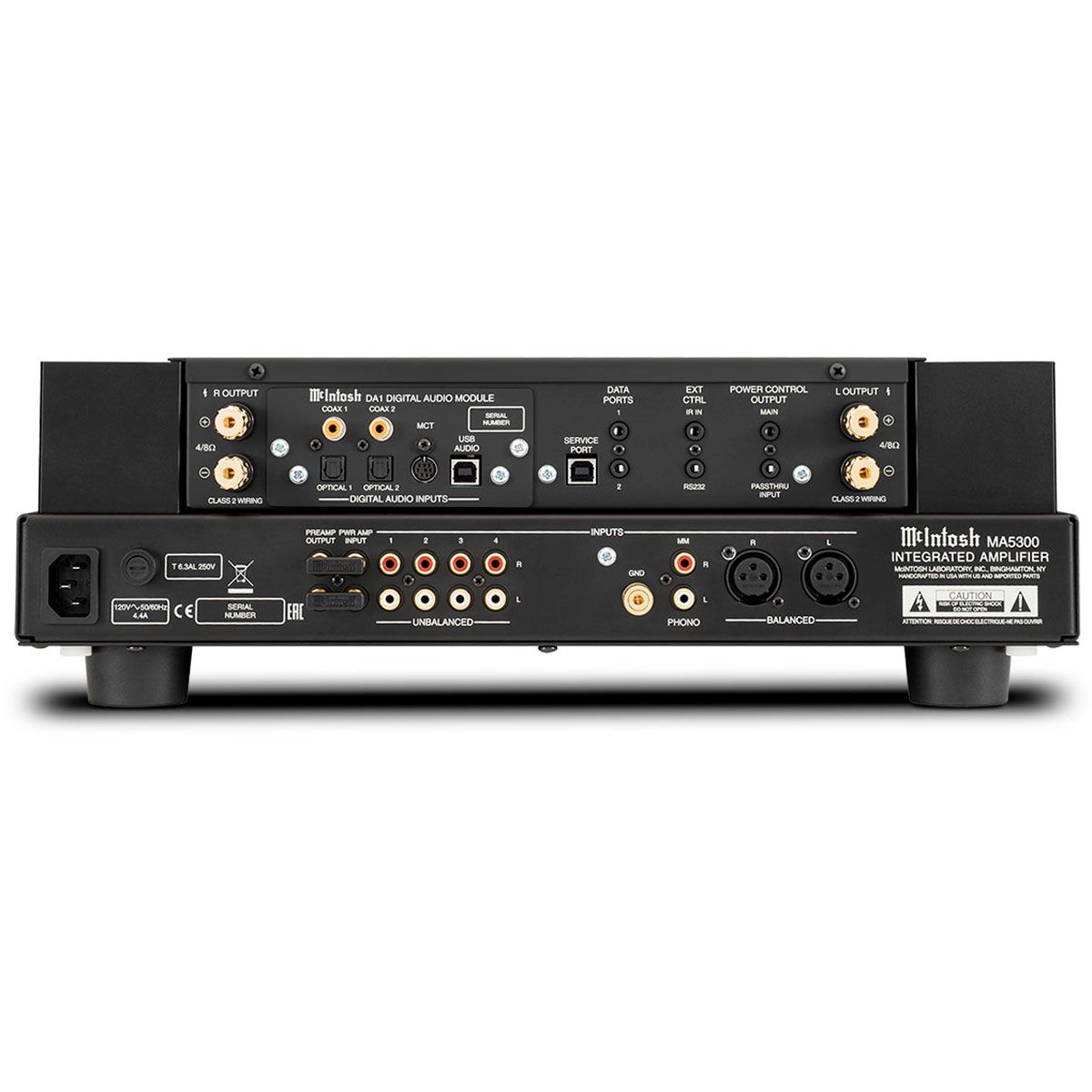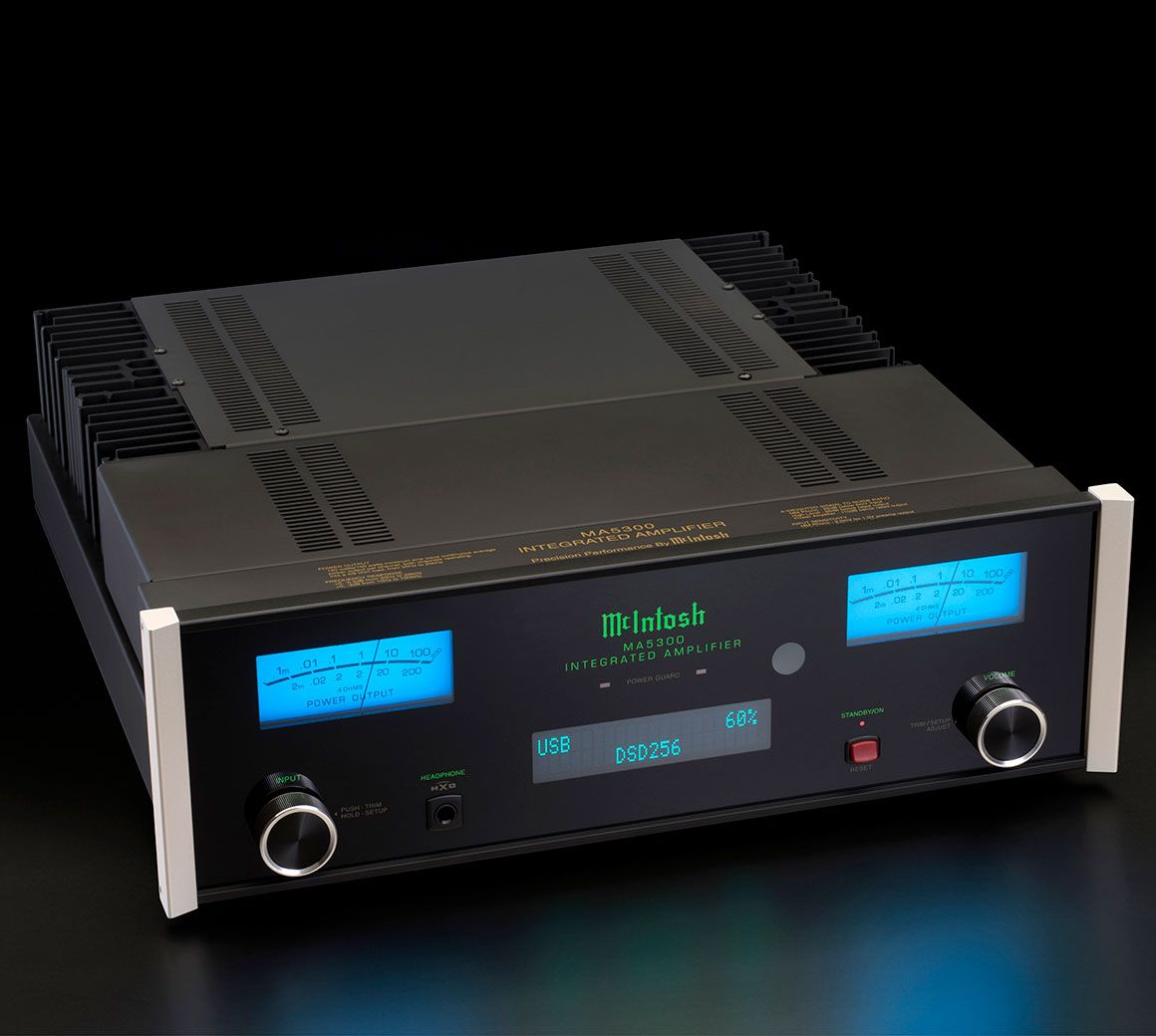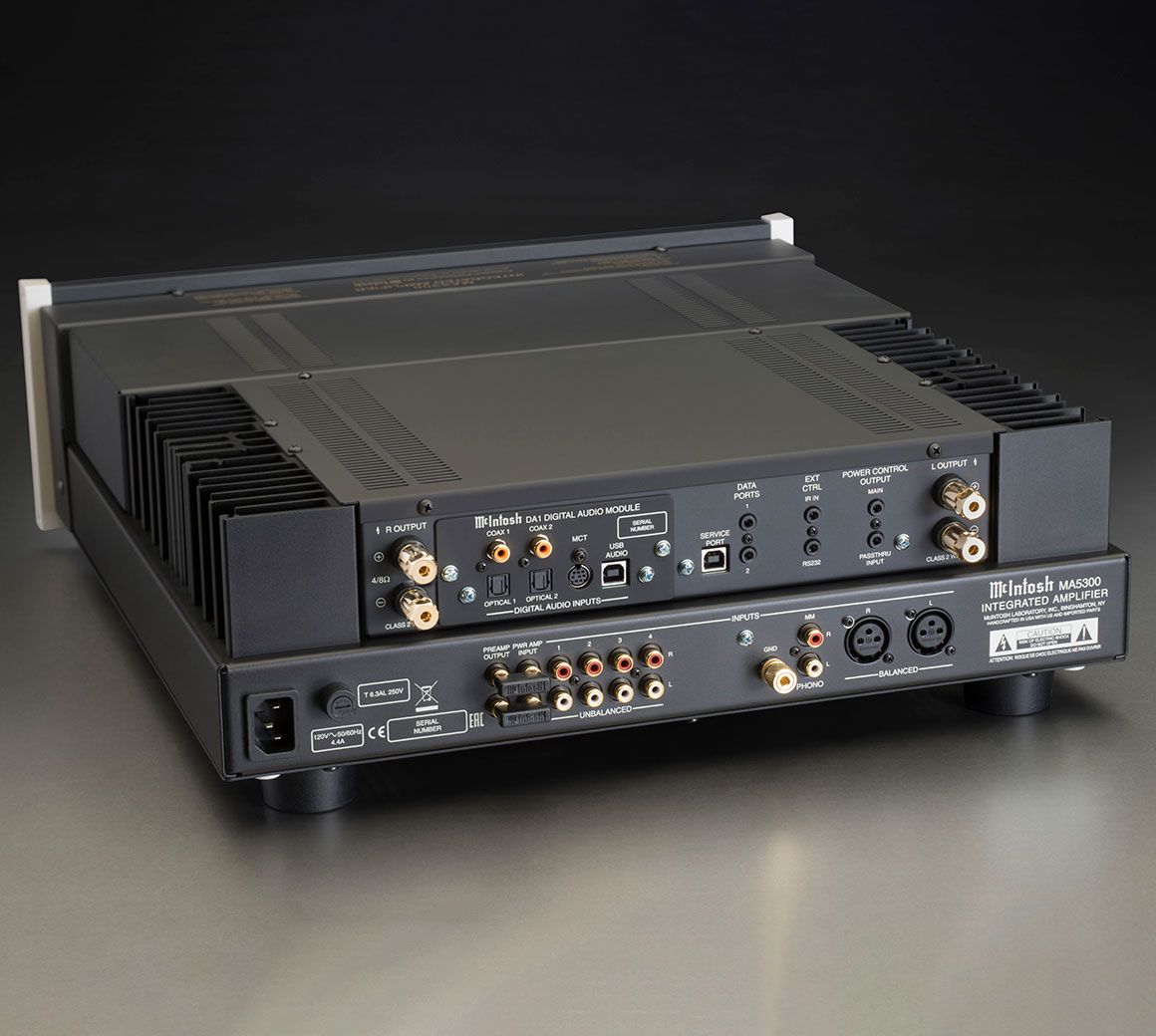McIntosh MA5300
100 Watt Integrated Amplifier w/ Built-In Phono Stage, Headphone Amp, Includes a DAC, USB DAC
The MA5300 Integrated Amplifier is proof that big sound can come in small packages. It is McIntosh's smallest solid-state integrated amplifier in terms of both power output and physical size, making it an ideal choice for smaller spaces or for someone just beginning to assemble a home audio system. It’s a direct coupled amplifier that delivers 100 Watts per channel into 8 Ohm speakers or 160 Watts per channel into 4 Ohm speakers. New dual scale blue Watt meters give an accurate readout of power output for both 4 and 8 Ohm impedances.
Company & Product Overview
Just across the Pennsylvania border about an hour south of Syracuse, New York, is the town of Binghamton. In 1951, this community became the home of what would go on to become one of the most sought after and iconic audio brands in recent history, McIntosh. They moved into the current location in 1956 and have been expanding their facility ever since. It is an interesting exercise to look up their address on Google Maps to see how the factory has expanded over time. McIntosh has also set up a company culture that is quite unique in manufacturing with an average employee tenure of 20+ years.
If you are ever lucky enough to get a factory tour, you’ll sense the pride in McIntosh products everywhere you go. At this factory, raw materials come in, and beautiful finished products go out! They bend their own metal, stuff their own boards, wind and pot their own transformers, cut their own glass, and much more. Plus, every single piece gets tested and burned in before it makes it inside a shipping carton. The McIntosh factory is a wonderful example of great American craftsmanship at work. And once you see those blue meters and green McIntosh logo behind the glass faceplate, you’ll probably want one for yourself, even before you listen to its great sound!

Another hallmark of the McIntosh brand is it has some of the best resale value of any audio components ever made. We feel this is due to several factors. First, McIntosh prides itself on being able to repair just about anything they have ever made. Second, they design their gear to last for decades with no sonic change. Finally, they have kept pretty much the same classic look since the very beginning.
Today’s review is on a piece from McIntosh that is in a somewhat competitive and very popular category, an integrated amp. While McIntosh is mostly known for their separate preamps and monster power amplifiers, they do make a few all in one units that combine both the preamp and amplifier. For those of you new to the audio world, the preamp is your control center where all of your signal switching takes place and the low-level signals coming in get amplified or digital signals coming in get converted to analog. They are then sent over to the power amp which takes that signal and amplifies it tremendously to power your speakers. When you put both the preamp and power amp in the same box, you have an integrated amplifier.
We will be taking a dive into the MA5300. In the McIntosh line up, this is their entry-level integrated amp, but in many respects, it’s far better than some other companies top of the line integrated amps!
Design & Build Quality
The design of the MA5300 is classic McIntosh. You’ll find a round volume control on the left and a round input selector on the right. The red power switch is on the right and the headphone input is located next to the input selector knob. In the center of the unit is the same type of display you see on almost all of their integrated amps and preamps giving you the volume level, input, and other info about the input you are on. This display also becomes the way you set up inputs and make other adjustments. This layout also makes it really easy to understand how to use a McIntosh component. With just one quick look, anyone can figure out how to turn it on and get your favorite tunes going. And the great part is, you can dive deeper to set up some cool features should you wish to, but you don’t have to.
We love the fact that even on their entry-level integrated amp, you get their iconic blue meters. You also get the same glass faceplate with aluminum end caps and the green logo behind the custom glass faceplate as most of their other gear. A fun fact is McIntosh puts all of the lettering on the backside of the glass faceplate to assure that even after decades of use, the lettering will not wear off!
On the McIntosh scale, the MA5300 is one of their smallest products. It’s pretty funny that their “smallest” product weighs in at almost 40 pounds! It is a McIntosh piece through and through with the exact same build quality you get when you buy their most expensive component. As a matter of fact, the same person who made the transformers for this integrated amp might be making the transformers for their top of the line mono amps next week! This level of perfection and craftsmanship is certainly rare in today’s world of disposable products and its just one reason the MA5300 is considered a great value by anyone who has tested it.
All of this attention to detail in the design and superb craftsmanship make it easy to see why McIntosh owners love their gear.
Features & Technology
The MA5300 is rated at 100 watts per channel into an 8-ohm speaker load and is capable of delivering 160 watts per channel into a 4-ohm load. A perfect amp (and there are really not many at all out there) would double its power into a 4-ohm load so the MA5300 comes pretty darn close. The Class AB amp section of the MA5300 has that same classic McIntosh warm, yet powerful and detailed sound we find in all of their amplifiers.
When you move it around to look at the rear panel, you’ll see it has plenty of inputs and control features. Along the bottom panel, you’ll find all of the analog inputs and outputs. There are four RCA analog audio inputs, a moving magnet phono stage input, and one pair of balanced audio inputs. The MA5300 also gives you a set of preamp-out/main-amp in connectors. These come jumpered together, however this allows you to add the McIntosh MEN220 room eq system or add a larger power amp later on down the road.

Across the top of the MA5300, there is a multitude of digital inputs. The cool part about the way McIntosh did the digital side of things, is its modular card. It has what is called the DA1 digital input board installed, but you can upgrade it to the better DA2.
This modular approach means your integrated amp will not go obsolete when digital technology changes over the years. McIntosh actually does almost all of their digital products this way. We love the modular approach as it allows you to just replace the digital section down the road should there be large changes in digital formats.
With the DA1 board, you get 2 coax digital inputs, 2 Toslink inputs, one USB input, and one special digital input for McIntosh MCT CD and SACD players. The DAC inside the DA1 is pretty special as it uses an 8-channel, 32-bit Digital-to-Analog Converter in Quad Balanced mode. It supports up to DSD256 and DXD 384kHz for high-resolution audio playback. This is an extremely flexible set of inputs allowing you to connect up just about any type of digital source. The MA5300 is also Roon tested if you are a fan of Roon, which we are here at Audio Advice.
On McIntosh preamps and integrated amps, you always get a great set of control connectors. McIntosh equipment is designed to talk to each other and there is a whole rabbit hole you can go down by having different pieces come on based upon what you did. There is also a rear IR and RS232 input for control for use with a smart remote or home control system. They literally thought of just about everything!
Many people want a great stereo system but only have one room in their home they can dedicate to music listening and enjoying home theater. McIntosh has an answer for this with their home theater bypass. You can connect up your favorite left and right speakers to the MA5300 for the best possible sound. Then, you simply use a home theater receiver that has preamp outs for the front channels. Almost all decent home theater receivers have this feature. You assign an input on the MA5300 to be the home theater bypass input. When you select this input, the sound from your home theater receiver passes straight through (and uses the great amp inside the MA5300 for your main speakers). The volume will be controlled with the home theater receiver remote. This is just a great feature that thankfully is starting to become more common on good two-channel gear.
When you set up your MA5300, you can just use the standard names for all of the inputs, but since there are 12 (yes, 12!) you might want to name them to make it easier to keep track. This is very simple to do with the front panel display and allows you to customize your system. While bass and treble controls may be frowned upon by some audiophiles, the MA5300 lets you totally bypass them or engage them for those old recordings that could use a little help.
The headphone jack on the front is far from an afterthought. It is made to support a very high-end pair of headphones with the ability to drive about any headphone on the market. It uses the McIntosh High Drive headphone amp technology and has their crossfade circuitry, which they call Headphone Crossfeed Director built-in. This is a circuit that has been around for a long time and many prefer to listen to headphones with crossfeed engaged. The MA5300 allows you to turn it on or off depending on the recording and your preference. You can even set it up to be on for one input and off for another, super flexible!
The MA5300 uses the trademarked McIntosh heatsinks with very high current output devices. They are set up to stay slightly warmed up so you don’t have to wait on the MA5300 to warm up for the best sound when you turn it on.
The amplifier section of the MA5300 shares two patented and famous McIntosh circuit designs. The first is Power Guard®. This is a very unique design to totally eliminate any chance of amplifier clipping. Clipping occurs at very loud listening levels when the power demands of the music overrun the ability of the amplifier. Clipping is not good for your speakers, amp, or your ears. It usually occurs when the listener has shall we say, imbibed a little too much fun, and cranks up the volume way louder than reasonable. In McIntosh products with Power Guard®, there is a background system that is comparing the signal coming in to the signal going out. It can react in 1/1000 of a second to reduce the signal from the preamp heading over to the amp to avoid clipping. With Power Guard® you never have to worry about hurting your speakers or amp. Sentry Monitor™ is another neat feature. This really only comes into play if you were connecting up your speakers with the amplifier turned on (a huge no no) but should you accidentally touch the positive and negative leads together, the circuit will shut down the output stage of the amp to avoid any damage.
With this host of features and its great performance, it’s easy to see why so many reviewers have rated the MA5300 so highly.
Performance
If you’ve read many of our reviews, you’ve figured out we usually like to put a product in a far more demanding situation than you would ever normally do to see how good it can perform. We were at it again with the MA5300. We pulled out our Mark Levinson ML534 power amp and ML519 digital preamp which sell for $40K for the pair and inserted the MA5300 to drive a very hard load in the Revel Salon 2. This is a speaker that typically needs a monster amp to bring out its best.
The MA5300 did surprisingly well, especially in the sound staging area. It was able to paint a big and full soundstage that was very three dimensional. However, as we suspected, there is no 100 watt integrated amp that could ever be able to drive the Revel Salon 2 and while it had full bass, it did not have the control a big, separate power amp can deliver.
We moved things around and selected a speaker that would be more normal for the price range of the MA5300. We chose the McIntosh XR50 speaker, which is a great bookshelf speaker and as we like to say here the MA5300 made them stand up and pay attention! We had great detail with never a sense at all of harshness and the soundstage was just huge when we got the placement of the XR50’s dialed in.
The MA5300 has a sound that is like most current McIntosh gear, warm, rich, yet detailed. It also gets the timing right so you will be tapping your toes to the music on those rhythmic passages. On most speakers other than something like the challenging Revel Salon 2, it will also make you smile with its bass impact. No, it’s not as good as a 300 watt McIntosh or Mark Levinson, but when you consider how its made and what it costs, it’s pretty impressive. And don’t forget, you could, in theory, start out with the MA5300 as an all in one component, then add a much more powerful McIntosh amp to it later and continue to use it as a preamp.
Overall Recommendation
The audio world is full of integrated amplifiers to choose from. We love the fact the MA5300 has the classic McIntosh look and sound, yet also has a future upgrade path with its modular digital board system. We can’t think of many $5,500 integrated amps out there with a better feature set or sound, and none have the 70+ year legacy you get with a handcrafted component from Binghamton, NY!
The MA5300’s complement of 12 inputs includes 6 analog inputs (4 unbalanced, 1 balanced and 1 Moving Magnet input for turntables) and 6 digital inputs (2 each coaxial and optical, 1 USB and 1 proprietary MCT for use with our MCT series of SACD/CD Transports). All digital inputs are housed in our DA1 Digital Audio Module which can be replaced by future modules as new digital audio technologies are developed. The DA1 comes with an 8-channel, 32-bit Digital-to-Analog Converter (DAC) used in Quad Balanced mode and supports up to DSD256 and DXD 384kHz for high-resolution audio playback. All inputs can be given user-friendly names to simplify system control and configuration.
Included on the MA5300 are McIntosh Monogrammed Heatsinks which are connected to advanced high current output transistors that eliminate warm-up time so you can enjoy the MA5300’s complete sonic capabilities from the moment you turn it on. Powerful new control microprocessors have been used to improve overall system operation, along with some of the latest audio-grade circuit components to deliver the best possible sound. Bass and treble tone controls have been added to help you further fine-tune your music to your personal preferences.
Rounding out the MA5300 are time tested McIntosh technologies including Power Guard, Sentry Monitor, Home Theater PassThru, High Drive headphone amplifier with Headphone Crossfeed Director (HXD), and gold-plated speaker binding posts. The classic McIntosh aesthetic of blue Watt meters, a black glass front panel with aluminum end caps, control knobs and illuminated logo completes the MA5300.
ELECTRONIC SPECIFICATIONS
- Power Output per Channel: 100 Watts into 8 Ohms 160 Watts into 4 Ohms
- Number of Channels: 2
- Speaker Impedance: 4 or 8 Ohms
- Rated Power Band: 20Hz to 20kHz
- Total Harmonic Distortion: 0.005%
- Dynamic Headroom: 1.8dB
- Frequency Response +0,-0.5dB: 20Hz to 20kHz
- Frequency Response +0, -3dB: 10Hz to 100kHz
- Sensitivity Phono (Moving Coil): N/A
- Sensitivity Phono (Moving Magnet): 2.5mV
- Sensitivity High Level (Balanced / Unbalanced): 0.5V/0.25V
- Sensitivity (Power Amp input): 1V
- Signal To Noise Ratio (Moving Coil): N/A
- Signal To Noise Ratio (Moving Magnet): 82dB
- Signal To Noise Ratio (High Level): 95dB
- Signal To Noise Ratio (Power Amp input): 110dB
- Input Impedance (Balanced / Unbalanced): 20K/20K
- Damping Factor: 8 Ohms: >200 / 4 Ohms: >100
- Maximum Output: (Balanced / Unbalanced) 8V Unbalanced
CONNECTIVITY
- Balanced Input: 1
- Unbalanced Input: 4
- Phono Input Moving Coil: 0
- Phono Input Moving Magnet: 1 (fixed loading)
- Upgradeable Digital Audio Module: Yes
- Digital Coaxial Input: 2
- Digital Optical Input: 2
- Digital MCT (DIN) Input: 1
- Digital USB Input: 1
- Balanced Variable Output: 0
- Unbalanced Fixed Output: 0
- Unbalanced Variable Output: 1
- Headphone Output: 1/4" High Drive with Headphone Crossfeed Director (HXD)
- Subwoofer Output: 0
- AM/FM Tuner option: No
- Home Theater PassThru: Yes
- Unbalanced Analog Connector Type: Standard
- Speaker Binding Post Type: Standard
- Service Port: 1
DIGITAL AUDIO SPECIFICATIONS
- Digital-to-Analog Converter (DAC) Type: 8-channel, 32-bit/384kHz PCM/DSD, Quad Balanced
- Digital Coaxial Input Sample Rate: 24-bit/44.1kHz to 192kHz
- Digital Optical Input Sample Rate: 24-bit/44.1kHz to 192kHz
- Digital MCT (DIN) Input Sample Rate: 16-bit/44.1kHz (CD) DSD64 (SACD)
- Digital USB Input Sample Rate: 32-bit/44.1kHz to 384kHz (PCM) DSD64, DSD128, DSD256, DXD352.8kHz, DXD384kHz
CONTROL
- Tone Controls: Bass and Treble
- Tone Bypass and Input Assign: Yes
- RS232 Control Input: Yes
- Power Control Output: 1 Main
- Rear Panel Data Port: 2 Rear
- Panel IR Sensor Input: Yes
- Input Level Match: Yes
GENERAL SPECIFICATIONS
- Vacuum Tube or Solid State: Solid State
- Output Type: Direct Coupled
- Output Meters: Yes
- Dual Layer Chassis: Yes
- Chassis Finish: Black painted steel
- McIntosh Monogrammed Heatsinks: Yes
| UPC | 842548106734 |
|---|---|
| Power Per Channel | 100 Watts into 8 Ohms 160 Watts into 4 Ohms |
| Number of Channels | 2 |
| Total Harmonic Distortion | 0.005% maximum from 20Hz to 20kHz |
| Signal To Noise Ratio | 95dB (High level) 82dB (Moving magnet) 110dB (Power amp input) |
| Frequency Response | 20Hz to 20kHz (+0,-0.5dB) 10Hz to 100kHz (+0, -3dB) |
| Gain | 15dB (High level) 60dB (Moving coil) 40dB (Moving Magnet) |
| Impedance | 4 or 8 Ohms (Speaker) / 20K/20K (Input: balanced / unbalanced) |
| Inputs | Analog: 4 Unbalanced, 1 Balanced, 1 Moving Magnet Digital: 2 Coax, 2 Optical, 1 USB, 1 MCT (used with McIntosh MCT series SACD/CD Transports), All are housed in DA1 Digital Audio Module. |
| Headphone Outputs | 1/4" High Drive with Headphone Crossfeed Director (HXD) |
| Number of Outputs | 5 |
| Power Requirements | 120V 50/60Hz, 2.3A / Standby: <0.25 Watts |
| Product Manual | Download |
| Warranty | 3 year limited warranty |

